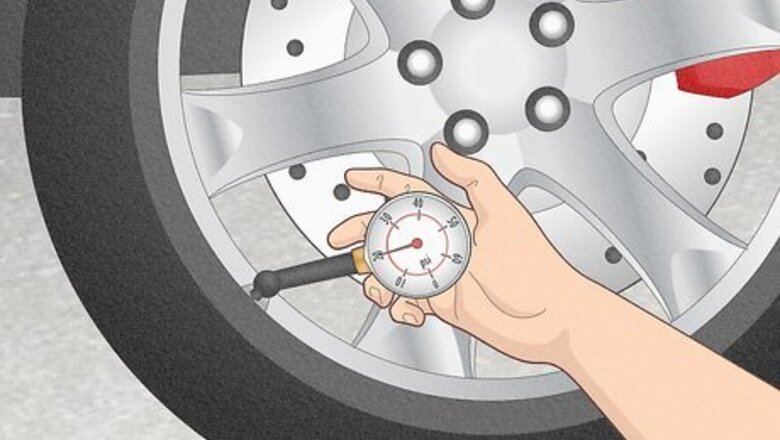
views
Adjust your tire pressure.
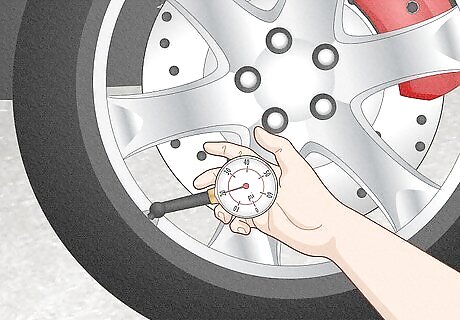
Use a tire pressure gauge to check the PSI. Check the owner's manual to see what the correct PSI is for your vehicle's tires. Remove the end cap on each tire's air valve and stick the pressure gauge inside. Press down quickly and look at the reading. If the PSI is too low, add a little air to the tire. If it's too high, press on the valve to release some of the air and check it again. Use a digital tire pressure gauge or a traditional stick-type gauge for this. You can usually use a stick-type gauge for free at your local gas station. Check the pressure when your tires are cold. You won't get an accurate reading if you've been driving on the tires for a while. Check the inflation and adjust it (if needed) once a month. A warning light will usually light up on your car's dash if there's an issue, though.
Get a routine alignment.
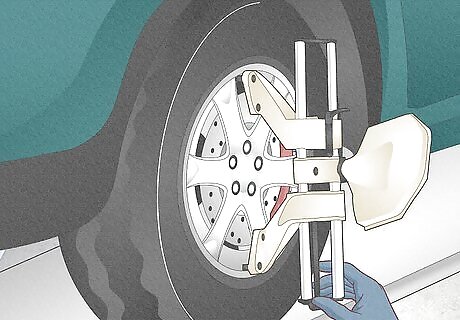
Bring your car to an auto shop at least once a year for alignment. Only a professional can do this, so take the car to a mechanic. An alignment is usually pretty cheap ($50 to $75) and it doesn't take long. If the auto shop isn't packed, you should be in and out in no time. Cars tend to veer slightly to one side or the other when alignment is off. If your tread doesn't look the same on all tires (for example, the front tires look more worn down than the back ones), your wheels are probably out of alignment. Schedule more frequent checkups if you drive in an area with lots of potholes and rough terrain.
Rotate your tires.
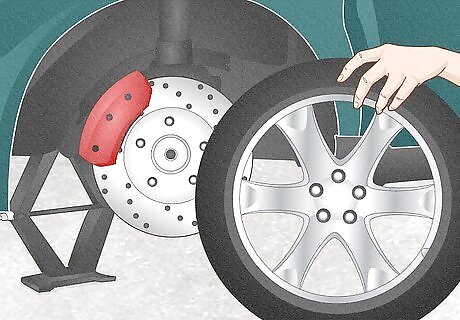
Take your car to an auto shop for this every 6,000 miles (9,700 km). Many mechanic shops will offer to rotate your tires and do an alignment during the same visit. Regularly rotating the tires ensures they wear evenly, which prevents excess strain on the steering and suspension system. When your tire tread wears down significantly, try to replace all 4 tires at the same time so they'll be perfectly balanced. If that's not in your budget, though, just make sure the new tire matches the size and shape of your current tires to prevent any problems.
Top off the power steering fluid if it's running low.
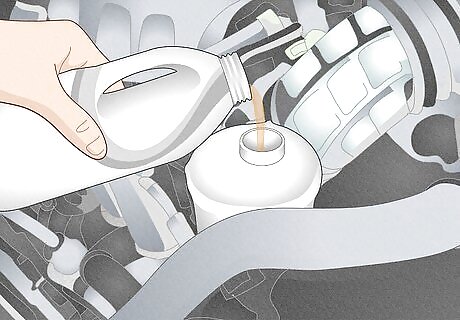
When you’re low on power steering fluid, the wheel may feel stiff. Open your car’s hood and unscrew the cap on the power steering fluid reservoir. Grab the power steering dipstick (it's usually attached to the reservoir cap or located nearby ) and stick it into the reservoir. The fluid should be slightly above the refill mark. If it isn't, it's too low. Fill the reservoir with fresh fluid until it's at the right level. Then, start your car, turn the wheel back and forth, and check the reservoir again. If the level dropped, add more fluid until you're fully topped off. See the owner's manual to determine what kind of power steering fluid your car needs. If the fluid level is low every time you check it, take your car in for service. You may have a leak.
Flush and replace contaminated power steering fluid.
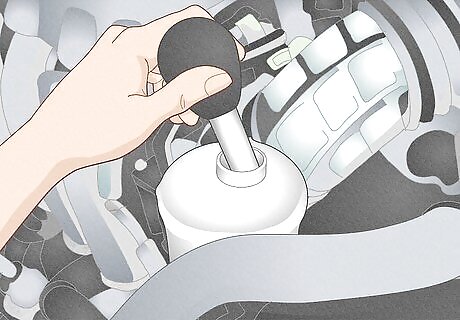
If the fluid looks black or brown instead of red, it’s contaminated. Unscrew the cap on the power steering reservoir and drain the bad fluid into a bucket or siphon it out with a turkey baster. Hop behind the wheel, turn the key, and move the steering wheel from side to side a few times until the last bit of old fluid bubbles up; drain that, too. Refill the reservoir about 3/4 of the way with fresh fluid. Start the engine again and turn the wheel back and forth a few times to get the fluid flowing. Then, fill up the reservoir the rest of the way with new fluid. Check your car's manual to see what kind of power steering fluid it needs. Bring drained fluids to an auto parts store, recycling facility, or transfer station to be disposed of properly. Never pour fluids down the sink or into the trash. If you don't have experience changing fluids, it's best to take your car to be professionally serviced. EXPERT TIP Hovig Manouchekian Hovig Manouchekian Auto Repair & Design Specialist Hovig Manouchekian is an Auto Repair and Design Specialist and the Manager of Funk Brothers Auto, a family-owned business operated since 1925. With over 30 years of experience in the automotive industry, Hovig specializes in the process of auto repair and maintenance. He is also very knowledgeable in common automotive issues and needs including engine repair, battery replacement, and windshield accessory and maintenance. Hovig's knowledge and hard work have contributed to Funk Brothers Auto winning Angie's List Super Service Award for five consecutive years. Hovig Manouchekian Hovig Manouchekian Auto Repair & Design Specialist Top up your power steering fluid to ensure a smooth ride. Contaminated power steering fluid is a common cause of a stiff steering wheel, as are low levels of fluid. Fix contaminated fluid with a system flush. If the fluid level is low, there may be a leak in the system. Keep the reservoir filled with fresh fluid.
Inspect the accessory belt(s) for damage.
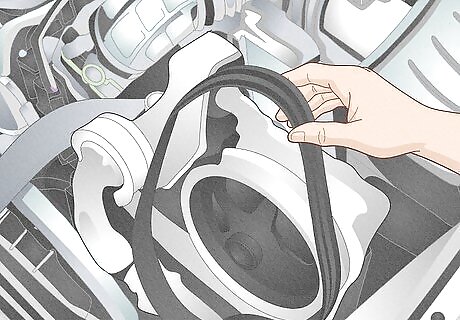
If you spot damage, get the belt(s) replaced as soon as you can. The serpentine belt or V-style belt (or possibly both, depending on your car) supplies power to your steering system. Pop the hood and check out your accessory belt(s) up close (use your owner's manual to locate them if you aren't sure). Look for damage like cracks, fraying, separating layers, cracks, or missing chunks on the underside. If you spot any damage, take your car to a professional ASAP to have the belt(s) replaced. Replace your serpentine belt every 60,000–90,000 miles (97,000–145,000 km) as a preventative measure. Some vehicles only have a V-belt. Others may have a serpentine belt and a V-belt. If you're unsure about anything, it's best to take your car to a mechanic.
Check for a slipped or loose belt.
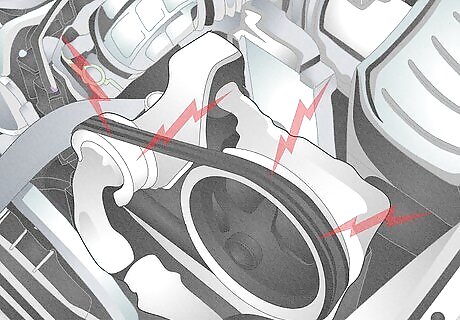
This may be the issue if your car suddenly doesn't turn. Belts slip or lose tension when they’re almost at their failing point, and they’re most likely to slip around tight turns. If your car suddenly gets very difficult to turn, it might have a slipped belt. You'll probably hear a high-pitched whine, chirping sounds, and/or vibration noises coming from under the hood, as well. Take your car in for service immediately if you suspect a slipped belt.
Get your car inspected for a worn-out steering rack.

Non-responsive steering means the steering rack is worn out. The steering rack converts the rotation from the wheel into linear motion to turn the tires. If you try to turn the wheel and the car keeps going straight, get your steering rack looked at by a professional mechanic and replaced immediately.
Check for symptoms of a bad steering pump.
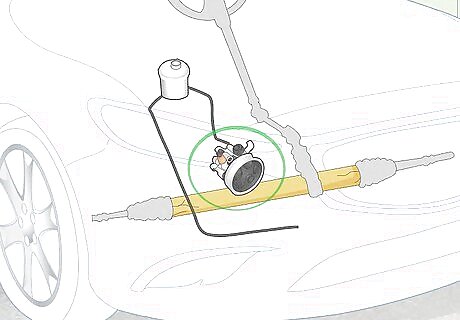
Tough steering, leaks, or grinding can signal a bad steering pump. The wheel may feel harder to turn or the car will pull to one side on its own. You may hear a squealing sound and feel excessive vibrating or bouncing when you're driving the vehicle. If you notice these symptoms, get a professional to fix your steering issue ASAP.















Comments
0 comment